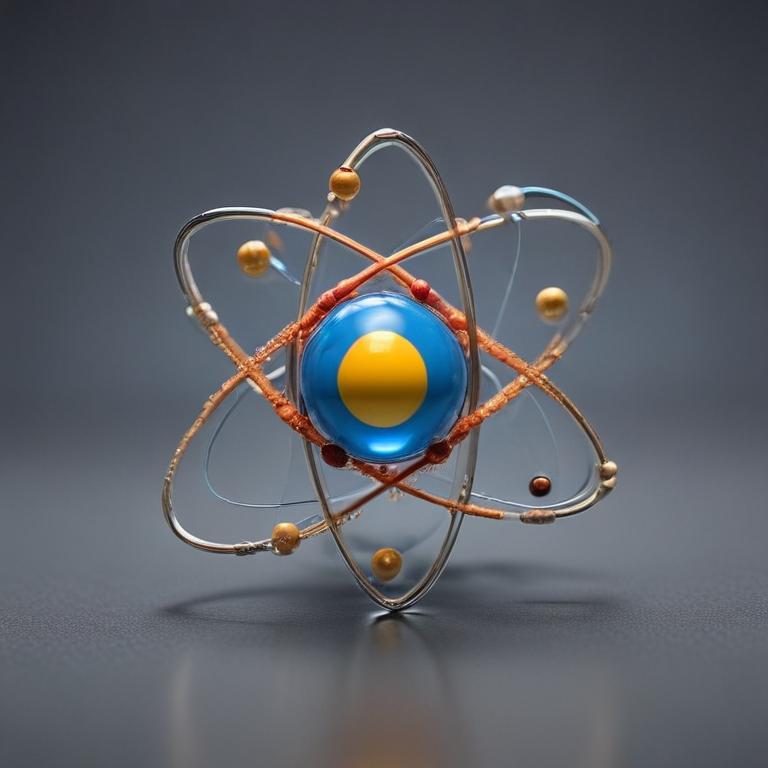发音 (Pronunciation):
IPA: /ˈætəm/
中文近似: 艾特姆
中文意思与词性 (Meanings & Part of Speech):
- 原子(构成物质的最小基本单位) (n.)
- 微量,极小量 (n.)
例句 (Examples):
1. An atom consists of protons, neutrons, and electrons.
(一个原子由质子、中子和电子组成。)
2. There isn't an atom of truth in what he says.
(他说的话里没有一丝真相。)
用法提示 (Usage Tip):
“atom”主要用于科学和比喻微小,对应“原子”和“极小量”,不要混淆为“分子(molecule)”,也不用于表示分解后最小的单位(那是“粒子 particle”)。
更多关于 "atom" (More about "atom")
单词来源 (Etymology)
“atom”来自希腊语“atomos”,意为“不可分割的”,最早被古希腊哲学家用于描述物质的最小单元。
词根词缀解析 (Root & Affix Analysis)
词根 a-(不)和-tom-(切、割),合起来为“不可再切分的单位”——即原子。是个常见的基础科学词汇。
“atom”的字母与词根个性化解读
字母象形/引申义 (个性化参考)
- 字母 'a' 的象形或引申含义可能包括: 牛角 (象形: 牛头, 力量, 能力); 下面宽上面尖 (形状) -> 延伸, 远处, 高处, 方向, 指示。
- 字母 't' 的象形或引申含义可能包括: 顶端 -> 记号/标志; 手杖 -> 抓 -> 手 -> 伸展 -> 指示代词; 支撑 -> 站立; 三叉 -> Tr转换/转; 分叉; 音变: T=D=S=TH。
- 字母 'o' 的象形或引申含义可能包括: 眼睛/嘴 (圆形) -> 张开, 转动; 圆柱; 音变: A=E=I=O=U=W=Y。
- 字母 'm' 的象形或引申含义可能包括: 山 (象形) -> 高大, 连接; 手 (男人劳动); 命令; 凸起 (嘴); 思维; 水面波纹; 音变: M=N=L=R; M=B=P=F=V。
学习提示:以上针对单词 atom 的字母和词根解读,主要基于提供的特定象形及词根资料。这些提示旨在启发联想,而非绝对定论。更通用的记忆规则和原则请参考首页。英语词源复杂多变,实际应用中请结合更全面的词源词典和语言学知识进行深入学习。
常用词组 (Common Phrases)
- split the atom: 裂变原子(指核裂变)
- atom bomb: 原子弹
其他语言 (Other Languages)
- 德语: Atom
- 法语: atome
字母整体创意联想
单词“atom”像是由四个部分组成的整体,就像原子的结构——A像原子的核,t像一根棒支撑,o像电子在旋转,m像两个小山峰,寓意着原子中各种粒子的排列。
逐字母创意解读
中文谐音助记
“atom”谐音“爱特姆”——‘爱’‘特别’‘小’的‘姆’(母)体,母体最小就是原子。
相关电影/名言
"The release of energy from splitting the atom changed the course of history."
(从分裂原子中释放出的能量改变了历史的进程。)
- 《奥本海默》(2023)
趣味知识/故事
“Atom”这个词虽然在今天指物理学中的原子,但最早在古希腊哲学中是被想象为不可再分割的微粒。直到后来科学发展,人们才发现原子其实还可以继续分为更小的粒子,比如质子、中子和电子,名字却一直保留了“不可分割”的含义。
拓展信息
在科学领域,“atom”几乎总是用于描述元素的基本构成单位。但在日常英文中,若搭配否定如“not an atom of...”,常用来强调“毫无某物”。
需要注意,“atom”与“molecule(分子)”不同,前者是构成化学元素的基本单位,后者是由原子组成的化学单位,比如水分子(H2O)。
此外,“atom”在一些科技和哲学文学中,还象征最基本、最小、不可分的事物。它也经常出现在科技和流行文化名称中,例如“Atom editor”或“Atom动力”。
网络参考 (More about "atom" from the Web)
Atom - Wikipedia
An atom consists of a nucleus of protons and generally neutrons, surrounded by an electromagnetically bound swarm of electrons. The chemical elements are distinguished from each other by the number of protons that are in their atoms. For example, any atom that contains 11 protons is sodium, and any atom that contains 29 protons is copper.
Atom | Definition, Structure, History, Examples, Diagram, & Facts ...
Most of the atom is empty space. The rest consists of three basic types of subatomic particles: protons, neutrons, and electrons.The protons and neutrons form the atom's central nucleus. (The ordinary hydrogen atom is an exception; it contains one proton but no neutrons.) As their names suggest, protons have a positive electrical charge, while neutrons are electrically neutral—they carry ...
What Is an Atom? Atom Definition - Science Notes and Projects
Learn what an atom is, how it is composed of protons, neutrons, and electrons, and how it forms elements, isotopes, and ions. Explore the history of atomic theory, the misconceptions and facts about atoms, and the difference between matter and antimatter atoms.
更多图片 (atom More Images)
